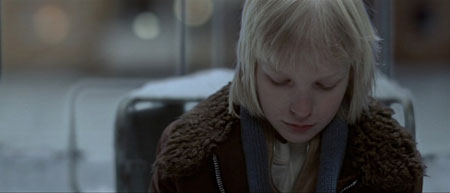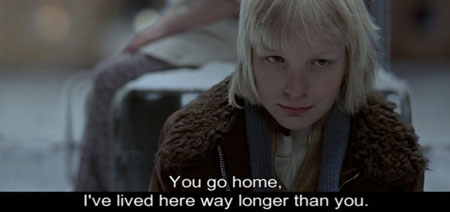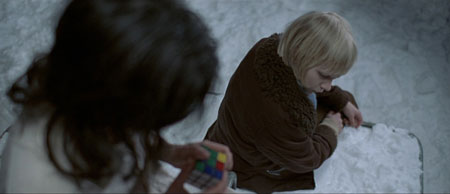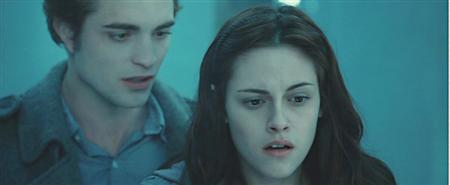Reading a sequence from Let the Right One In
Let the Right One In (Sweden 2008) is used as a Case Study for Chapter 3 Genres in The Media Student’s Book. This reading extends that case study and also serves as material for Chapter 1, Approaching media texts.
On the DVD the sequence begins at 19 minutes, 18 seconds, chapter 3, and lasts for 2.47 minutes.
(To get the most from this close reading, you probably need to watch the whole film more than once and this short sequence several times.)
Introduction – Oskar
If you haven’t seen the film, it is set in a suburb of Stockholm in the early 1980s – the winter snows have begun. A 12 year-old boy lives with his mother in a block of flats and one evening a man and a girl move into the next door flats.
This short sequence is the second direct meeting between Oskar and Eli (he also observed her arrival at the opening of the film). It begins with Oskar outside the block of flats attempting to solve the puzzle of Rubik’s Cube. The first thing to note is that despite the freezing weather, Oskar is presented as preferring to be outside rather than inside with his mother watching television. This is signified by the warm clothes he is wearing which are not buttoned up. He is also lacking a hat and gloves. The lack of gloves might be necessary in order to manipulate the cube, but we do get the impression that Oskar is used to being ‘outside’ in the cold, both literally and metaphorically. Casting, costume and make-up/hair work together in representing Oskar as a pale skinned boy with lank blonde hair and an almost permanent sniffle.

Image 1, MCU Oskar, frame grab
The first shot
The first shot is a Medium Close-Up (MCU) of Oskar (Image 1) who is placed in the foreground and slightly to the right of the CinemaScope (2.35:1) frame. The shape of the image is important and the director and cinematographer use it effectively. As well as the framing, it is important to note that there is shallow focus which means that only the foreground is defined – the background is blurred. The empty space and blurring prepare us for Eli’s arrival.
The camera holds steady as Eli comes into the frame. The sound design means that we hear two sound effects – Oskar manipulating the cube and Eli as she climbs onto the frame behind him. We see Oskar glance (just a slight lifting of his eyes and turn of his head – almost imperceptibly) to his right when Eli is seated. We also hear the non-diegetic music score It is difficult to distinguish at this point. First it appears to be a single throbbing sustained note (possibly what composer Johan Söderqvist refers to as a sample from a ‘bass waterphone’), but later the slow mournful strings of the Slovak National Symphony Orchestra are mixed in. (The score has been widely praised and attracted interest around the world.)
Camerawork and editing
This first shot is held for 13 seconds before a cut to a similar MCU of Eli, framed in much the same way, except that she is towards the left of the frame and she looks down and to her left – in the direction of Oskar. A useful exercise with a sequence as short as this is to count the shots. There are 25 in total. This gives an average shot length (ASL) of 6.6 seconds (i.e. dividing 2’ 47” by 25). By the standards of contemporary Hollywood this is quite a slow pace of editing (1 to 2 secs is the norm with some Hollywood action films). However, analysis of the shots themselves shows a pattern of ‘shot – reverse shot’ of each of the two characters for much of the sequence in a quite conventional style. These shots are often less than 5 seconds in length but interspersed are some much longer ‘takes’. Shot 20 is held for 26 seconds and shot 25 for 19 seconds. It is these shots in which we are invited to consider what the characters are thinking and to observe reactions.
The framings are generally MCU/CU of Eli and Oskar – of their faces and hands holding the Rubik’s Cube. The director doesn’t need to show the general environment because we have seen it earlier – we know where we are. But by holding so close to Oskar he is also able to allow Eli to slip into the frame, building up the idea that she can easily move to any position that she wants to adopt (later we will see her leaping and flying). On a couple of occasions the camera follows the Rubik’s Cube as it is handed from one character to the other and there are another couple of shots which frame both characters, once from a high angle and once from a low angle. Is it significant that Eli remains above Oskar in both shots? (see Image 3)
The camerawork and editing for the last two shots is quite complex. Eli is now sitting with her back to Oskar, having taken the cube. The camera looks towards Oskar who stands up and moves away. The dark coat he is wearing acts like a fade to black as it fills the screen. The editor then cuts to reveal Eli’s hands on the cube (i.e. the camera has moved around the climbing frame.) It then moves up to frame Eli in CU as she first bends double in pain and then lifts her face to look offscreen.
The sequence is carefully shot and edited. It is a bit of a surprise then to find a jump cut between shots 18 and 19 (at 1.33). The jump cut occurs because the editor is forced to cut between two shots of similar size framing the same subject (Oskar’s hands working the cube, then his face looking down). It would have been smoother (and more in keeping with the other shots and transitions in the sequence) to have moved the camera (pan or tilt) or possibly to raise it to avoid cutting. Why doesn’t that happen? Possibly it is simply a mistake which on a relatively low budget shoot can’t be reshot – or perhaps it is placed there deliberately? Most audiences won’t see it without the benefit of a shot analysis like this.
The relationship
Much of the power of the film depends on the construction for the audience of a special relationship between the two characters. The clues to this construction are carefully laid in these early scenes. There isn’t much dialogue in the sequence here, but it is significant. It is partly a kind of tennis match. Eli says “So you’re back” and Oskar repeats the line. Then she says “I want to be left alone” – “So do I” Oskar responds. Eli says that he should go home and Oskar says that she should go home – he has lived in the flats longer.

Image 2, Oskar begins to smile to himself as he challenges Eli.
What is important here is that Oskar doesn’t look at Eli, she has to peer over his shoulder. And when he makes the crack about having lived there longer he looks up and away from Eli and smiles. We’ve already seen Oskar being bullied by boys at school, but this exchange shows that he is not afraid of Eli. Perhaps there is something about her that he recognises/understands. Two lonely people together? The rest of the dialogue covers the Rubik’s Cube and Oskar noticing both Eli’s clothes and her smell. There is a nice balance between the ‘competitive’ dialogue and the physical separation of the two characters.
The Rubik’s Cube
The Rubik’s Cube is important in several different ways. First it is a cultural referent. Let the Right One In is not a ‘realist’ film as such, but it is set in a real time and place – a named Stockholm suburb in October 1981. For Swedish audiences, there are various clues to the historical setting, including news reports about a Russian submarine in Swedish waters. The Rubik’s Cube was an international sensation at the time – a difficult hand-held puzzle, similar in social use perhaps to a Gameboy twenty years later?
But as well as representing the era in some way, the puzzle has an important narrative function. Eli is interested because she needs puzzles – how else is she to pass the time? The cube in this sense becomes a traditional narrative device. At this point in the film, we don’t know that much about Eli. Later she will return the cube having solved the puzzle, an early indication of her powers. Later still in the narrative, we will become aware of the value of her puzzle collection and begin to understand more about her – perhaps then remembering this exchange of the cube.

Image 3, Two-shot of Eli (an ‘over the shoulder’ shot) with Oskar below. He is sniffing Eli’s smell. The shallow depth of field focuses attention on Oskar.
Eli
Though we don’t yet fully realise her predicament at this point, Eli is suffering from a lack of blood. This is the reason that she has a ‘funny smell’ – and why she looks so pale and haggard. (In fact, Eli’s appearance seems to change throughout the film according to when she last drank blood. Audiences have noted how she can look older and younger, more masculine and more feminine.) At the end of the sequence this is conveyed effectively through sound, camerawork and performance. When Oskar leaves, Eli is doubled up in pain and we hear the sound of her stomach rumbling – it has been there for some time but the sound increases as she bends and winces.

Image 4, CU of Eli – her exhaled breath is just visible in the cold air
The sound is something like a flock of birds fluttering wings and cawing – mixed with the mournful strings of the score. Note how Eli’s exhalation is given authenticity by the visual image of her breath as it freezes in the cold. This makes us notice again how she is dressed in only a thin white shirt and light trousers. We also hear the sound of her exhalation and the sound of the door closing as Oscar goes back inside. In image 4, Eli is looking down and offscreen – signifying that the character is thinking about something. Moments like this are difficult to grasp on a first viewing, but if you watch the film several times it becomes clear that this sequence is partly about Eli’s desperate loneliness and her need for human comfort.
Summary
Seemingly, little happens in this sequence. For a ‘vampire film’ there is an absence of dramatic action. Yet if we read the sound and images carefully – as the film invites us to do – we soon recognise that we are learning about the characters and picking up essential narrative information. At this point we don’t fully realise that the tension between the two is there because they are on the edge of an emotional relationship – and also that Oskar might be in danger because Eli could attack him for his blood. Again, we might remember this scene later when the relationship is more fully formed. Overall, this subtlety in presentation is what makes the film so successful.
Genre
Let the Right One In has been chosen as an example of a different kind of genre film – one which combines the ‘coming-of-age’ romance with the horror film/vampire film in ways that are unusual in comparison with Hollywood. It’s worth comparing this sequence with one from Twilight (US 2008). In that film the two lead characters meet in the forest where Bella and Edward have a similar exchange although by this point in the film (start of Chapter 8 on the DVD), Bella is sure that Edward is a vampire.

Edward and Bella – two-shot in Twilight (frame grab)
Twilight is much more clearly signalled as ‘romance’ but it is also more expressionistic in its setting of the dark gothic forest and also more open about the references to familiar vampire folklore. Image 5 shows Edward and Bella in a two shot. They are much closer together, although again they do not look at each other as Bella challenges Edward as to his vampiric state. The shot demonstrates a similar muted colour palette and like Oskar, Bella is pale – just like Edward and Eli. The difference in generic terms is that Twilight signals to the audience much more clearly what the repertoires are and how they are being used.